If you had told my teenage self that in ten years, given the option of going literally anywhere in the world and doing anything I would choose to live at a Buddhist monastery in the forest and meditate in silence for five hours a day, I would have laughed at you. Yet that’s exactly what I ended up doing for four days of my Southeast Asia travels.
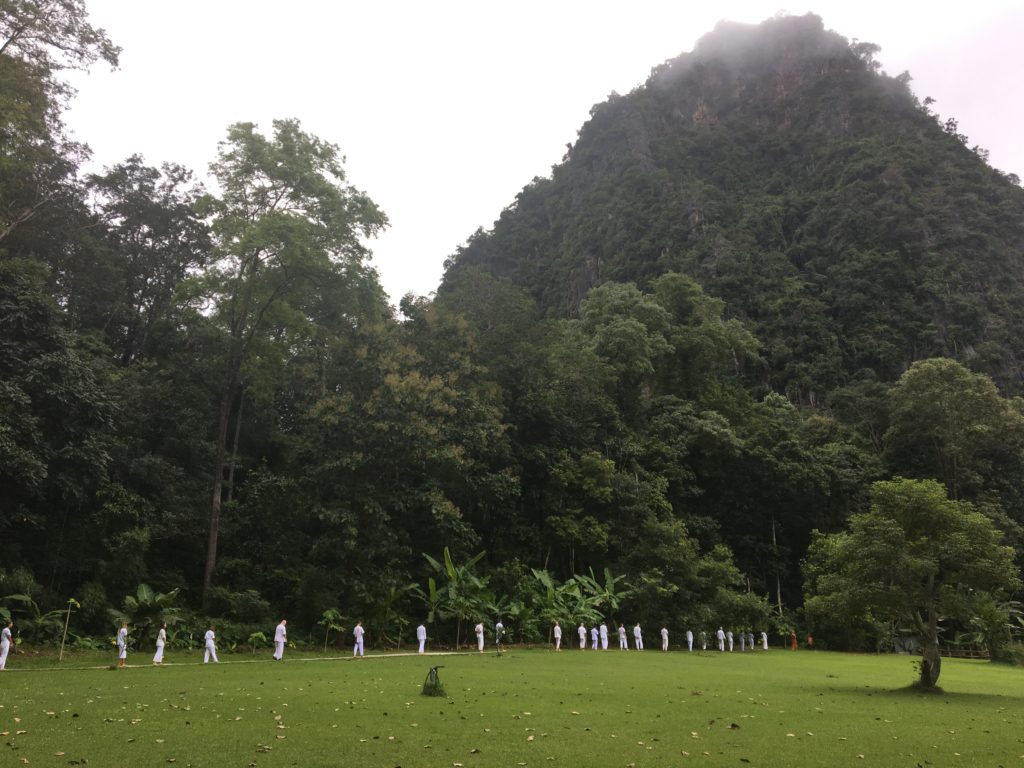
I grew up at a Japanese American Buddhist Church (OCBC ftw), but never took Buddhism or its principles very seriously. Being kind to every living being just didn’t seem as appealing to me as gossiping about my peers, I guess, and back then, I liked to rebel against any sort of religious identification for the sake of being unique and nonconformist (freeformist?). I attended Dharma (Sunday) School almost entirely because I had a crush on a boy there and he told me via AIM to come thru. I nodded off in nearly every morning service.
So why the decision to go to Wat Pa Tam Wua, a Buddhist monastery in the forest of far-out northern Thailand? Because over the past few months, I’ve realized that there’s a lot more to Buddhism than just being a nice person: the ultimate goal is liberation from suffering, coincidentally the exact same goal of social justice movements. But instead of solely focusing on fighting the effects of human suffering (stopping wars, abolishing prisons, regulating corporate power – all essential things), Buddhism seeks to go beyond the leaves – to use a tree metaphor for the health of humanity – to change the very root of our suffering: our own minds and relationship to moment-to-moment mental and physical experiences. This is done primarily through meditation to gain insight into our true nature and the reality of things. And most importantly, it’s not a set of beliefs one blindly follows – it’s a toolkit; something you have to undergo yourself and experience personally to realize.
What this looks like in theory and practice would take pages and pages to explain, but I have to catch a flight to Manila so I’ll make a clumsy attempt to summarize, X-treme CliffNotes-style. The kind of meditation I’ve been exploring, Vipassana, is all about training ourselves to notice the stream of thoughts and feelings we have as they are happening, usually a completely unconscious process, in order to free ourselves from them. Instead of being in constant reaction-mode to our various emotions and thoughts and letting them control us all the time, we observe them neutrally, and because we are aware of them, they naturally fall away and lose their power over us. When we successfully achieve awareness and de-condition our minds, what’s left is a peaceful, loving, compassionate self. This is done primarily by focusing on the process of our breathing – in and out – and using it as a reference point to see exactly when the mind wanders away. This is a practice that obviously requires a lot more than four days of work – most official courses are ten days, which I couldn’t quite muster up the enthusiasm for yet, and even that is just a starting point for years and years of de-conditioning work. But nevertheless, even getting a little taster of Vipassana was an eye-opening experience. Here’s how it all went down.
The Place
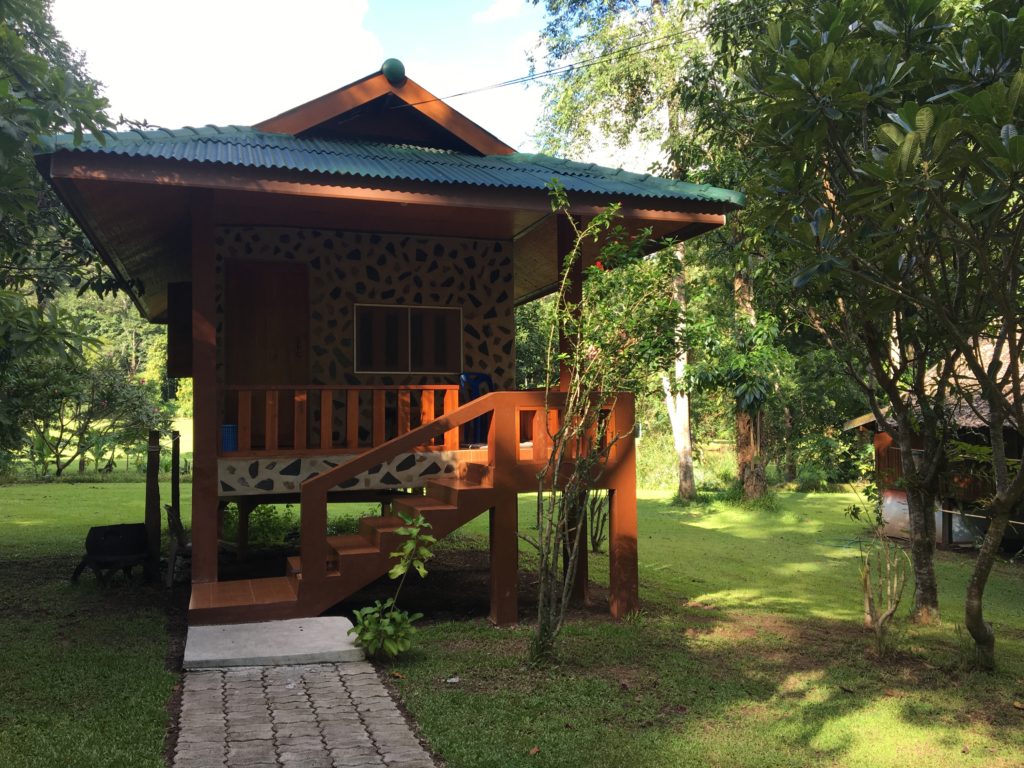
Meditating with monks at a monastery in the forest of a faraway land sounds kind of sexy in a way, but I can assure you that it’s not. At all. It’s by far the least sexy atmosphere I’ve ever been in. True, the green mountain scenery is breathtaking and I got a private bungalow and two delicious meals a day completely free of charge, but that’s as glamorous as it gets. The monastery has a strict code of discipline to create the right environment of focus. Everyone has to dress head to toe in white, covering our shoulders and knees, and all of the following are strictly forbidden: talking loudly, singing (!), doing yoga, eating after 12PM (yes, noon), alcohol, touching the opposite sex or talking to them after 8:30PM, and also more extreme things like stealing and killing that are unspoken rules in most other places too. “It’s good to talk less and eat less”, explained the lady at the front desk during my orientation session.
There were around 60 attendees when I was there, that come from all over the world – I never figured out where most of them were from because of the whole “better to talk less” thing. I had brief chats with a few women from Thailand, Malaysia, and Mexico though. But most of the time, we all kept to ourselves, a nice break from normal social obligations. The day to day schedule is as follows: we wake up at 5:00AM and meditate in our rooms for an hour and a half, then feed rice to the monks at 6:30AM, then eat breakfast, then launch into two hours of walking, sitting and lying down meditation, then lunch, then two more hours of meditation, then chores, then a break, then an hour of chanting, then an hour of meditation, then go back to our rooms at 8PM for two more hours of meditation. So technically, that’s eight and a half hours of doing nothing except following our breath. I ended up cheating on this and used the private practice time to read books on Buddhism and okay, also check Facebook and Instagram before my iPhone data ran out, but that still left me with five hours’ worth of meditation a day. The longest meditation session I had done before Thailand was a grand total of twenty minutes, and that felt like an eternity, so I was pretty intimidated by what I was about to walk into.
The Struggle
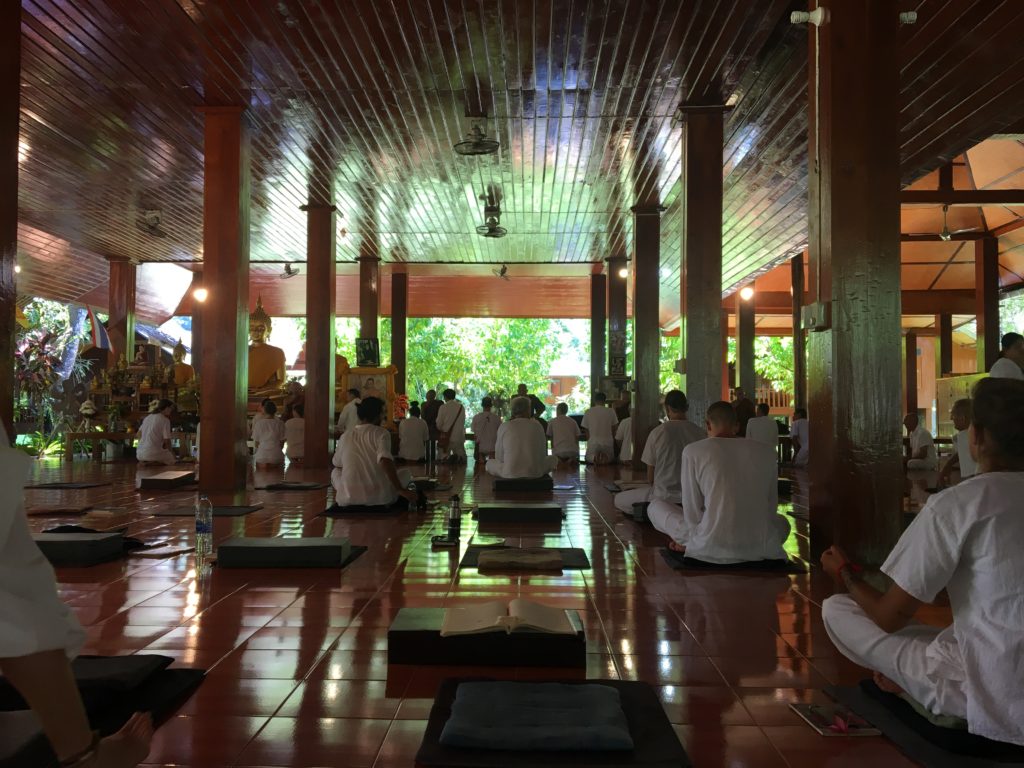
For the first four sitting and lying down meditation sessions I attempted, not only was I unsuccessful at concentrating on my breath, but I couldn’t even stay awake. I have a special talent for being able to sleep through the most extreme of circumstances – on top of brick walls, during fire drills and earthquakes, etc (former roommates will attest to this), but this unique skill did not serve me at the monastery. I would sit cross-legged on a cushion on the floor, close my eyes, and bam!, almost instantly lose consciousness. Then I would try to bring myself back, but I ended up in this weird no-man’s land between awake and asleep mixing up dreams with reality and experienced all of these bizarre hallucinations, like a row of food suddenly appearing at the front of the room and everyone standing up to go over and eat it (clearly I was struggling with the no-food-after-noon rule), or a stream of thousands of insects bursting through the wall. No other people I talked to had this problem of falling asleep during every session, so I quickly and forlornly realized that I had a very long hill ahead of me to climb.
After adjusting to the schedule a bit, I managed to mostly stay awake in the following few sessions, but then found out that I was only able to focus on my breath for ten seconds tops before my mind would speed off on a completely random line of thought. I was so unaware of this happening that I would be consumed in a fantasy about the Mindfulness Project, camping with my friends, whatever, for several minutes until I finally thought shit, I’m supposed to be following my breath! Okay in…. out….. in…. out…. then promptly got lost down another rabbit hole of fantasy. At this point, I started to panic. Why am I here? I started to silently scream at myself. I could be scuba diving on a beautiful island or stomping around jungles but instead I’m sitting on a cushion on my ass for five hours a day in silence – why would anyone do that to themselves?
Probably the only thing that saved me were the books. One unexpected byproduct of spending so much time without external distraction was that my attention span started to dramatically increase. Back at home, it takes me weeks to get through a book because I am struck with a very necessary urge to check my Facebook notifications after every page, but here, I found I could sit for hours in intensive concentration – after the monotony of meditation, book-reading was a blessed relief. I ended up reading three whole books in three days, all of which gave me a much deeper understanding of the vipassana practice and Buddhism in general. And what I learned was so compelling and inspiring that I resolved to go into my sessions with new dedication and energy.
Living in the Present
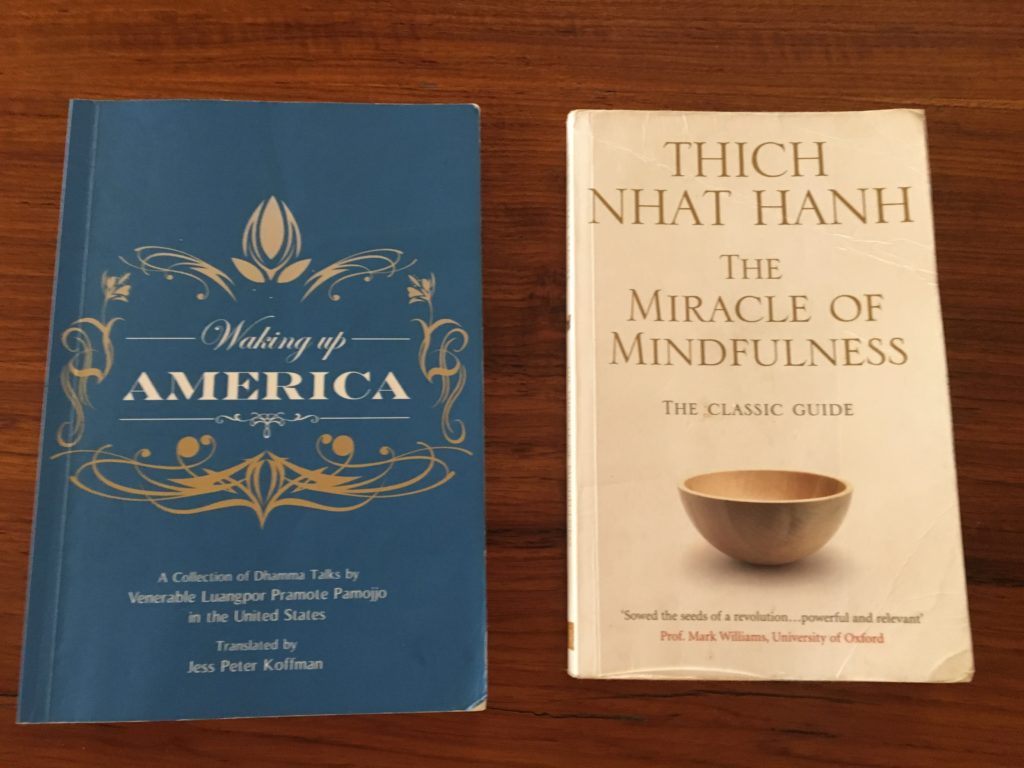
One of the books I read was “The Miracle of Mindfulness” by Thich Nhat Hanh (what a guy), which explained that practicing mindfulness can and should be done in every waking moment, not just during meditation.
“Mindfulness frees us of forgetfulness and dispersion and makes it possible to live fully each minute of life. Mindfulness enables us to live…While washing the dishes, you might be thinking about the tea afterwards, and so try to get them out of the way as quickly as possible in order to sit and drink tea. But that means you are incapable of living during the time you are washing the dishes. When you are washing the dishes, washing the dishes must be the most important thing in your life. Just as when you’re drinking tea, drinking tea must be the most important thing in your life.”
I decided to try this during my next breakfast – to concentrate entirely on the process of eating while eating. I sat down with my delectable rice and eggplant dish, followed my breath in and out a few times to calm my mind, then took one small bite. And then chewed, willing myself to slow down my chewing until it felt like I was going in slow motion. My natural instinct was to immediately get ready for the next bite while I was chewing the first, but I resisted and instead concentrated on the current food in my mouth. I considered the flavors and how they changed as I chewed. I registered the initial heat transitioning to mouth-temperature. I felt each individual grain of rice on my tongue. I marveled at how rich, how full, the experience was. I remembered to keep breathing steadily throughout, and started to notice when a thought would pop in, like “I want to teach my future kids to eat like this”, then let it go and returned to my breath.
After a while, I slipped into a wondrous state of intense presence. Once the eggplant rice dish was consumed, I moved onto my banana. I focused on that banana like it was the last thing I would ever eat. I ran my fingers across its surface, registering its smooth texture, even pressed it against my head to feel its cool temperature against my skin. I thought, “wow, this seems sexual“, then remembered I was in the least sexually charged environment ever, then went back to my breath. As I peeled it in slow motion, I noticed how I could feel the slow ripping of the skin away from the fruit. I studied the banana and saw all of these tiny sparkles on its surface, sparkles I had never registered before in any of the approximately five thousand bananas I’ve consumed over the course of my life. Then I took a tiny, minuscule slice of a bite.
The amount of flavor packed into that little slice was mind-blowing. It was tangy and sweet and creamy and so, so good. After about fifteen minutes I finally finished and walked over to wash my plate off. I felt the grainy floor under my bare feet, felt the cool underside of my plate, the smoothness of its ceramic texture. I registered how the plate became lighter as I tipped the banana peel into the compost. I reflected about how little of the food I’ve eaten in my life I’ve actually tasted because my head has been so consumed by thoughts. I wondered about how many other experiences I’ve been missing out on because of my tendency to live in the past and future, rather than the present moment.
Noticing Feelings
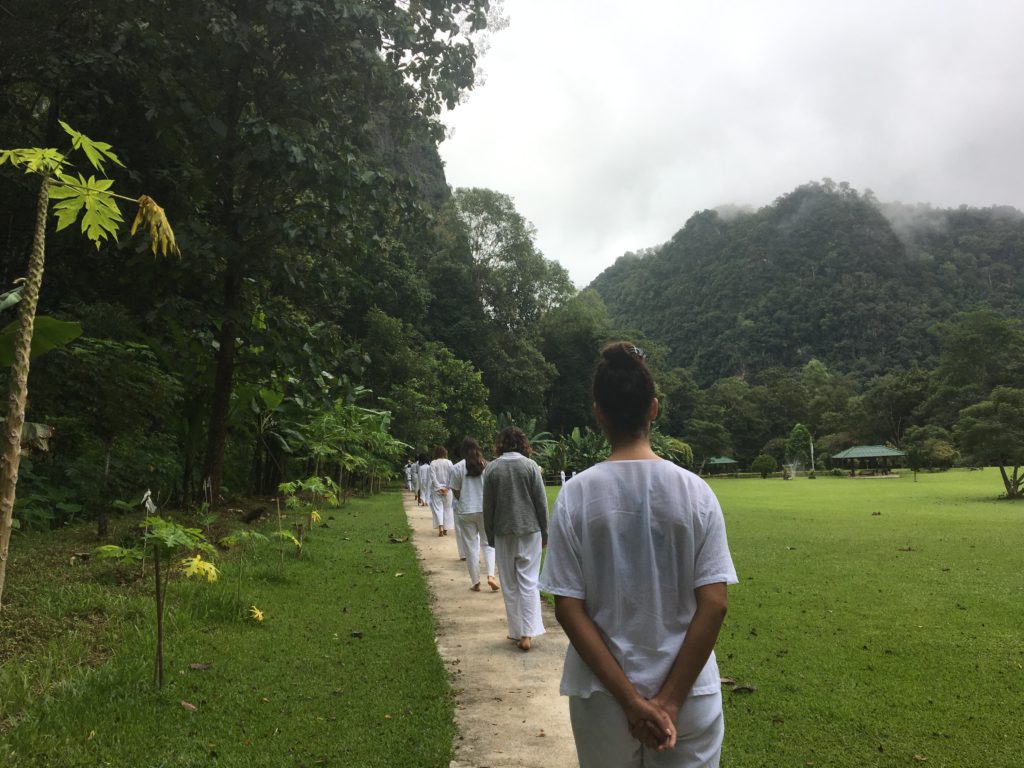
Mindfulness is about registering what is happening to us without judgement or attachment so we can act rather than react to these sensations. Part of that practice is to neutrally observe our feelings as they come up. Most of the time, we’re so caught up in our feelings that we don’t even register what they are, but if we calm our bodies and minds by following our breath, we start from a place of relaxation and peace and emotions become easier to register because of the contrast. Does that make sense? This is the first time I’m explaining all these concepts. I don’t know why I’m asking you questions as if I expect answers to be telepathically sent to me over the Internet. Anyway.
I started to focus on noticing my feelings as they sprung up throughout the day. Sometimes it was very subtle, like a feeling of happiness has arisen in me when I spotted a butterfly resting on a rock during walking meditation. Other times it was most turbulent, like a feeling of anxiety and shame has hardcore arisen in me when I over-slept and missed giving alms to the monks before breakfast then told the breakfast lady I missed it because I was sick so that I could get breakfast. I realized three things by naming my feelings throughout the day: one, that I go through a shit ton of feelings that are constantly coming and going and changing, two, that these feelings all have physical manifestations of some sort in my body, and three, that noticing my feelings as they happen enable me to be free of them.
By noticing how I felt about the lie at breakfast and how the anxiety felt in my body (my chest tightened and my breathing became uneven), I was able to slow my breathing back down again to calm the physical sensation instead of getting caught up in it, and make peace with myself by instead of letting the cloud of shame hang over me the whole day by simply resolving to wake up on time the next day. Sometimes I would register my feelings after I had already reacted to them, like when a bald white guy with glasses came up to me out of nowhere and uttered an enthusiastic phrase in Chinese and when I said “what?” he said “are you Chinese?” and I shot back aggressively, “no, I’m from California” and stomped away. Only then did I realize that I had felt anger and reacted purely out of that emotion. If I had registered my anger when it happened, I could have stopped its power from taking over me and acted in a more productive and compassionate way. Oh well. He’ll be okay.
Meditation Breakthrough
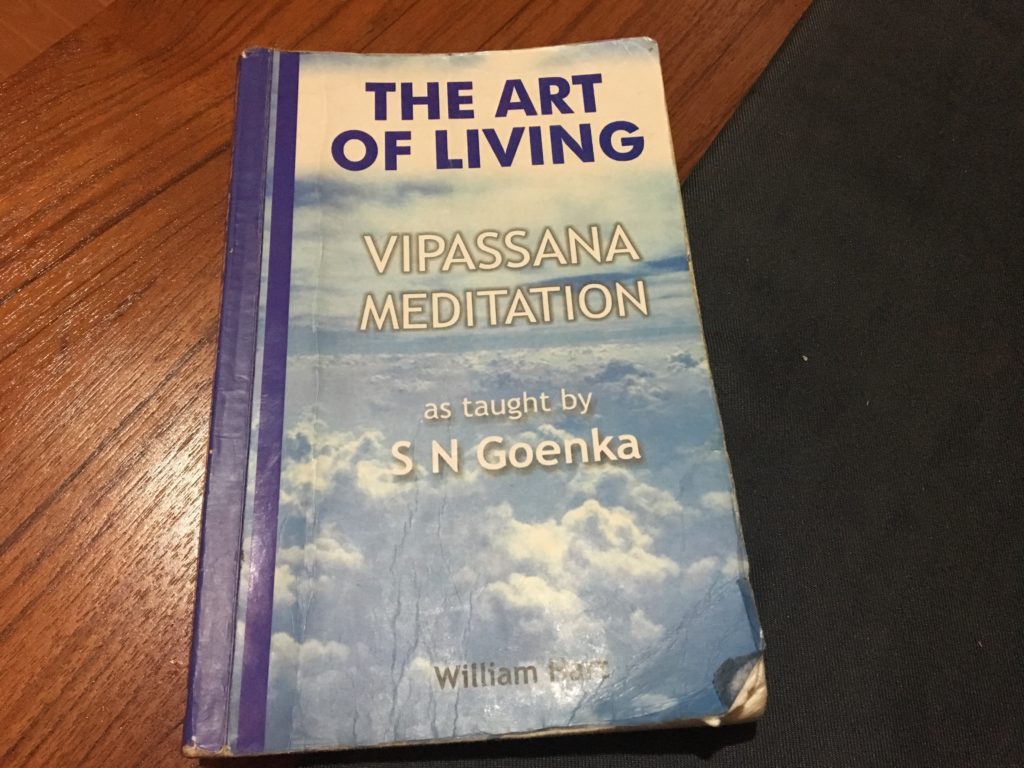
On my last day at the monastery, I still hadn’t managed to focus on my breath for more than ten seconds without the use of a mantra or counting, like I am inhaling, one, I am exhaling, one. I am inhaling, two, I am exhaling, two. In Vipassana, mantras are kind of like cheating because you’re unnaturally controlling your breath/mind instead of just observing it. For my final session, I decided to take our abbot’s advice and just relax into the meditation. I closed my eyes, half-smiled (Thich Nhat Hanh’s recommendation), straightened my back and started following each breath I took.
At first, each inhale and exhale was unnaturally slow and deliberate as I willed my thoughts to settle down, but then they became shallower and more natural. I felt each inhale and exhale in my nostrils, cooler air in, and cooler air out. The sensation felt bright and clear.
And something amazing happened: instead of being a monotonous, excruciating experience, it felt… peaceful. Wonderful. Like I was getting this incredible rest after a long, exhausting day. And indeed, it was the first time in my life I experienced what it was like to be completely free of the constant flow of thoughts that usually overwhelm me.
Oh shit, I just leveled up my meditation game, I thought. AND I totally caught that I was thinking just now, AND I’m totally aware that I’m thinking right now! Okay, back to meditating.
Other than a few lines of thought that dropped in every few minutes, I maintained following my breath throughout the whole 45 minute session. After it was over, the peace in my mind and body continued for several minutes. I looked around the room and felt strangely loving towards everyone around me, instead of the usual indifference or judgement. Compassion naturally arises from a quieted mind, say all the books – I guess they’re right.
Final Thoughts
Four days at a monastery didn’t make me a zen master, and I still haven’t yet completely bought into the concept of surrendering all of my worldly craving and desire for the sake of enlightenment. But I’ve gained a glimpse into my true nature at a level that’s deeper than I’ve ever experienced before, and I definitely want to develop this further and see where it goes. I’m blown away by how powerful the act of just following my breath is – how it can help me master my emotions, act with a clear head, and find peace, even if just for a few moments.
Ultimately, the best thing about mindfulness is that you don’t have to live in a forest monastery in Thailand to do it – you can practice it in every moment of your day-to-day life. But I’m thankful that I decided to spend part of my time here immersing myself in Buddhist practice and culture, because we Westerners have a lot to learn from this kind of wisdom. We have a lot to gain from realizing that happiness doesn’t come from chasing dreams of big houses and fancy cars, but rather from within ourselves. And who knows – maybe one day it can help change the world.
If you’re in learning more about meditation and Buddhist practice, I highly recommend “The Art of Living: Vipassana Meditation as taught by S.N. Goenka” for a very thorough explanation of why and how to do it.
You can Google “engaged Buddhism” if you’re interested in exploring the intersection of social justice and meditation/Buddhism as well. Also when I get back let’s hang out and have some deep talks about all this stuff too!
I’m currently reading Mindfulness in Plain English which focusses on Vipassana and this was a very interesting post. Have you been keeping up with your meditation after the trip and have you improved any other parts of your life from it? No more angry outbursts at Asian men? Lol